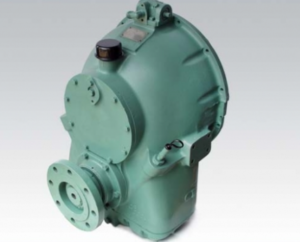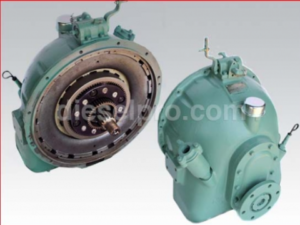

Allison M Rebuilt Marine Transmission
Overhaul Kit & Related Components For Allison M
Allison M Seals
Allison M Clutch Plates
Allison M Hydraulic Pump
Allison M Selector Valve & Related Components
Allison M Bearings & Related Components
Allison MH Rebuilt Transmission
Allison MH Overhaul Kit & Related Components
Allison MH Seals
Allison MH Clutch Plates & Related Components
Allison MH Hydraulic Pump
Allison MH Selector Valve
Allison MH Bearings & Related Components
Identifying Signs of Wear For Allison M & MH Marine Transmissions
Regular inspection of bearings and gears is critical to maintaining the reliability, performance, and longevity of Allison M & MH marine transmissions. While these transmissions are known for their rugged construction and exceptional durability, wear is inevitable over time due to friction, torque loading, thermal cycling, and contamination.
Recognizing the early signs of wear allows for targeted repairs before total transmission failure occurs.
Common Indicators of Gear and Bearing Wear
- Unusual Noise
- Grinding, whining, or clunking sounds under load or during shifting typically signal gear tooth damage or worn bearings.
- Whining noises in forward or reverse may indicate misalignment or pitting on the gears.
- Vibration
- Excessive or irregular vibration felt at the propeller shaft or through the hull may result from failing bearings, worn gear teeth, or shaft misalignment.
- Excessive or irregular vibration felt at the propeller shaft or through the hull may result from failing bearings, worn gear teeth, or shaft misalignment.
- Metallic Debris in Fluid
- Fine metallic particles on the magnetic drain plug or in the filter suggest bearing degradation.
- Large flakes or chunks may point to catastrophic gear tooth failure.
- Erratic Shifting or Slipping
- While often linked to clutch wear or hydraulic issues, slipping can also stem from gear wear that prevents full tooth engagement.
- While often linked to clutch wear or hydraulic issues, slipping can also stem from gear wear that prevents full tooth engagement.
- Overheating
- Worn gears and bearings increase friction, causing heat buildup and fluid breakdown.
- Worn gears and bearings increase friction, causing heat buildup and fluid breakdown.
- Visible Oil Leaks at Output Shaft
- Excessive play from worn bearings can lead to seal wear and persistent leakage.
- Excessive play from worn bearings can lead to seal wear and persistent leakage.
These symptoms typically evolve over time, so establishing a performance baseline and tracking changes over each maintenance cycle is essential.
Disassembly Prep and Safety For Allison M & MH Marine Transmissions
Disassembling the transmission to access the gear train and bearings is a significant task that must be performed with safety and precision. Allison M & MH marine gearboxes are built with tight tolerances, and improper handling can lead to further damage or injury.
Tools and Materials Needed
- Full socket set (SAE), including deep sockets
- Torque wrenches (foot-pounds and inch-pounds)
- Gear pullers, bearing splitters, and press tools
- Soft mallets and alignment punches
- Bearing drivers or hydraulic press
- Clean catch pans, solvent tank, lint-free rags
- Safety glasses, gloves, and non-slip shoes
- Engine hoist or transmission lift rated for 500+ lbs
Safety Best Practices
- Disconnect power from the engine and ensure the vessel is secure and immobilized.
- Drain all fluid completely before opening the transmission. Hot oil can cause burns.
- Tag and photograph all wiring and linkage before removal to ensure proper reinstallation.
- Support the transmission fully before removing mounting bolts.
- Avoid using impact tools near bearing housings or gear teeth.
Work Area Setup
- Use a clean, flat workbench or assembly table.
- Label all removed components and fasteners.
- Organize parts in sequence of removal for easy reassembly.
- Place fragile parts such as thrust washers or needle bearings on soft, clean surfaces.
A clean, controlled work environment is vital when opening a transmission. Any contamination or mix-up of components can result in misalignment, loss of hydraulic pressure, or immediate failure after reassembly.
Gear Inspection Tolerances For Allison M & MH Marine Transmissions
The gears within Allison M & MH marine transmissions are engineered to operate under significant stress while maintaining extremely precise clearances. During inspection, it’s essential to check for wear, damage, and deviations from factory tolerances.
Key Gear Types in Allison M & MH Transmissions
- Input Drive Gears – Transmit engine torque to the gear train.
- Forward/Reverse Clutch Gears – Transfer motion depending on selected gear.
- Planetary Gear Sets (MH) – Provide reduction and rotational reversal.
- Output Shaft Gears – Deliver rotational torque to the propeller shaft.
Inspection Checklist
-
Visual Examination
- Look for chipped or broken teeth, pitting, discoloration (overheating), and spalling.
- Check gear bores and shafts for scoring or out-of-round wear.
- Inspect all thrust washers for uneven wear patterns.
-
Backlash Measurement
- Use a dial indicator to measure gear-to-gear play (backlash).
- Acceptable backlash for Allison marine gears typically ranges from 0.006″ to 0.014″ depending on the gear type.
- Excessive backlash leads to hammering, noise, and reduced shift smoothness.
-
Runout Testing
- Mount gear on V-blocks and rotate with a dial indicator touching the face.
- Runout should be under 0.002″–0.005″; higher readings indicate warping or shaft misalignment.
-
Tooth Pattern Contact
- Apply marking compound (Prussian blue) and rotate gears under light load.
- Proper gear contact shows even engagement across the center of the tooth face.
- Edge wear or localized patterns suggest misalignment or worn bearings.
-
Hardness Testing (optional)
- In commercial overhaul shops, gear hardness can be tested to determine whether gears are fatigued or still within spec.
- Softened teeth from overheating or overloading are not reusable.
Any gear showing signs of cracking, flaking, or overheating must be replaced—no exceptions. Reusing a compromised gear risks catastrophic failure.
Bearing Removal and Press-Fit Install For Allison M & MH Marine Transmissions
Bearings support and stabilize rotating shafts under heavy load and constant vibration. In Allison M & MH transmissions, tapered roller bearings, needle bearings, and journal bearings are commonly used on the input shaft, gear clusters, and output shaft.
Bearing Removal Procedures
- Clean the Area Thoroughly
- Remove any debris, oil, or metal particles that could fall into exposed housings.
- Remove any debris, oil, or metal particles that could fall into exposed housings.
- Identify Bearing Type and Fit
- Determine if the bearing is a press-fit, interference-fit, or slip-fit.
- Determine if the bearing is a press-fit, interference-fit, or slip-fit.
- Use Proper Tools
- Use a bearing puller or bearing splitter with a press—never use a hammer.
- For tapered roller bearings:
- Support the outer race during extraction.
- Remove retaining clips or lock rings before pulling.
- Check Shaft and Housing Condition
- Look for scoring, heat discoloration, or galling.
- Clean shafts with emery cloth if needed.
- Remove Bearing Cups from Housings
- Use a driver tool or press.
- Heat the housing slightly if needed (no more than 250°F) to ease removal.
Bearing Installation Procedures
- Freeze Bearings or Heat Housings
- For interference fits, freeze the bearing for 1–2 hours and/or heat the housing to 200–250°F.
- Do not exceed manufacturer-recommended limits or apply open flame.
- Use a Bearing Driver or Press
- Press only on the correct race (inner for shaft fit, outer for housing fit).
- Ensure bearing seats fully and squarely.
- Verify Endplay or Preload
- Use shims or spacers to establish correct preload or clearance.
- Use a dial indicator to measure shaft endplay.
- Typical endplay ranges:
- Input shaft: 0.002″–0.005″
- Output shaft: 0.004″–0.010″
- Lubricate Bearings Before Assembly
- Use marine-rated bearing grease or pre-fill with clean transmission oil.
- Use marine-rated bearing grease or pre-fill with clean transmission oil.
- Reinstall Retainers, Clips, and Thrust Washers
- Torque all retaining bolts to spec.
- Apply thread locker if specified.
Bearings should never be reused unless their entire life history is known and tolerances verified. Always use new, matched bearing sets when servicing the gear train.
Rechecking Alignment and Backlash For Allison M & MH Marine Transmissions
Once all gears and bearings are reinstalled, the final critical step is verifying proper alignment and backlash between mating components. These checks ensure smooth operation, minimal vibration, and long-term durability.
Shaft and Gear Alignment Checks
- Check Gear Mesh with Feeler Gauges
- Insert gauges between gear flanks and rotate to measure resistance.
- Compare to backlash specifications—adjust via shims if needed.
- Use Dial Indicators for Shaft Runout
- Mount indicator on transmission case and rotate shaft.
- Total Indicated Runout (TIR) should not exceed 0.002″–0.005″.
- Confirm Axial Clearance
- For planetary gearsets, check carrier float and sun gear clearance.
- For planetary gearsets, check carrier float and sun gear clearance.
- Verify Output Shaft Centerline
- Output shaft must align concentrically with propeller shaft coupling.
- Measure with a precision alignment tool or laser.
- Check Gear Pattern Contact Again
- Rotate gears under light load and examine marking compound contact.
- Adjust shims or thrust washers if pattern is off-center or uneven.
Torque Final Hardware
- All bolts holding bearing carriers, gear retainers, and pressure plates must be torqued to OEM specs.
- Re-torque after initial test run.
Post-Rebuild Pressure Test
- Connect a hydraulic test gauge to the main pressure port.
- With the engine running at idle, verify normal pressure range (see prior section).
- Shift through forward and reverse while monitoring pressure consistency.
Test Run with Load
- Perform a short sea trial or load test on land.
- Listen for gear noise, monitor temperature, and confirm shifting behavior.
If all values fall within tolerance and no unusual sounds or performance issues occur, the rebuild is considered successful.
Final Notes On Inspecting and Replacing Bearings and Gears For Allison M & MH Marine Transmissions
Replacing bearings and gears in an Allison M or MH transmission is a highly technical process—but one that can extend the service life of your transmission by thousands of hours when done correctly.
Key takeaways:
- Never ignore vibration, noise, or shifting irregularities—they’re often early signs of internal wear.
- Use the correct tools and measurement instruments—accuracy is everything.
- Only use high-quality bearings and gears that meet or exceed OEM specs.
- Always check and recheck tolerances, backlash, and alignment after reassembly.
At Diesel Pro Power, we support mechanics and operators by supplying:
- Complete bearing kits
- Gear sets and thrust washers
- Alignment tools and feeler gauges
- Rebuild kits that include gaskets, seals, and clutch components
If you’re planning a rebuild or simply troubleshooting abnormal operation, this section gives you the detail needed to handle the job professionally.
Allison M Rebuilt Marine Transmission
Overhaul Kit & Related Components For Allison M
Allison M Seals
Allison M Clutch Plates
Allison M Hydraulic Pump
Allison M Selector Valve & Related Components
Allison M Bearings & Related Components
Allison MH Rebuilt Transmission
Allison MH Overhaul Kit & Related Components
Allison MH Seals
Allison MH Clutch Plates & Related Components
Allison MH Hydraulic Pump
Allison MH Selector Valve
Allison MH Bearings & Related Components



 Free US Calls: 1-888-433-4735
Free US Calls: 1-888-433-4735 International: 305-545-5588
International: 305-545-5588